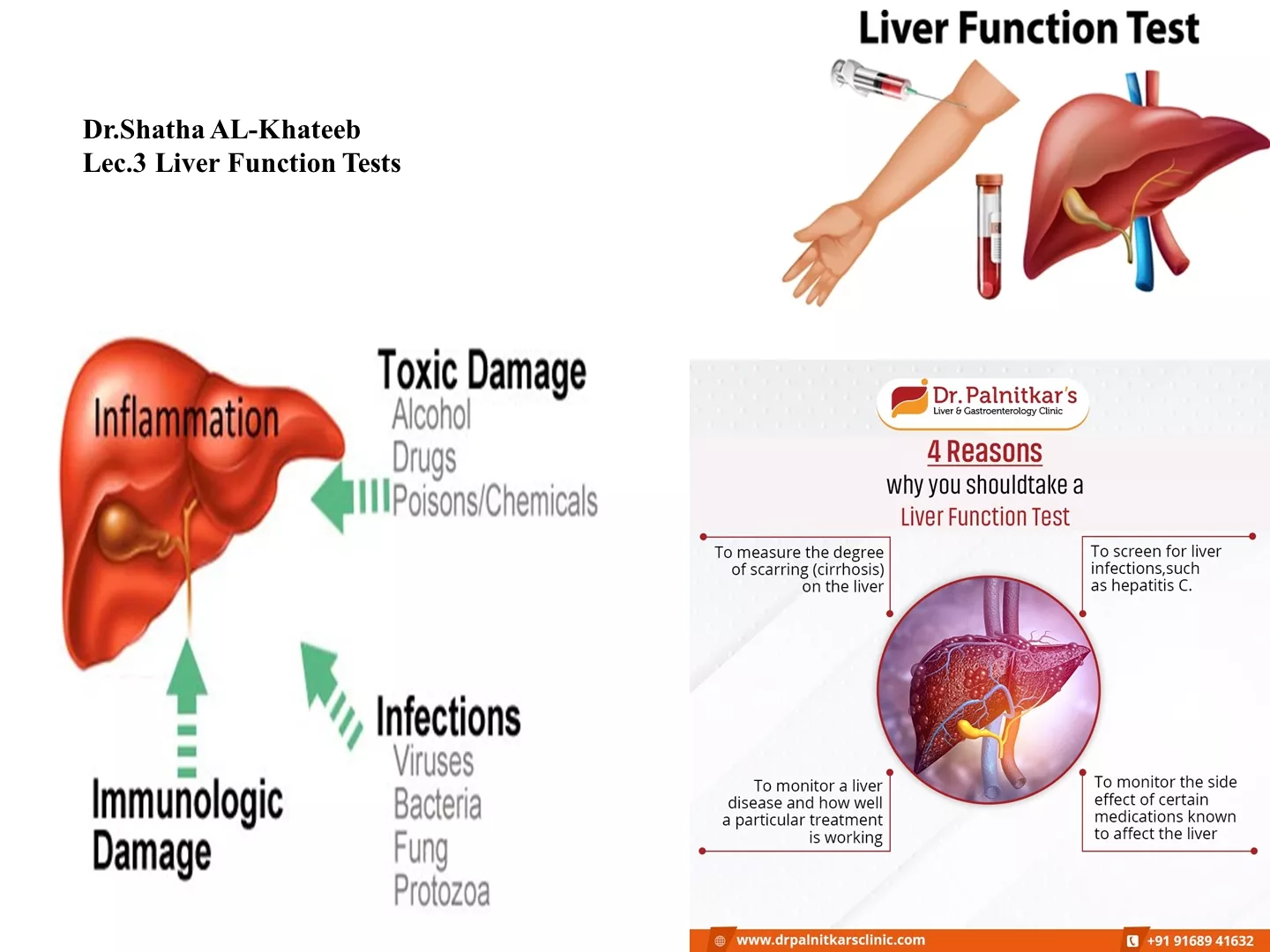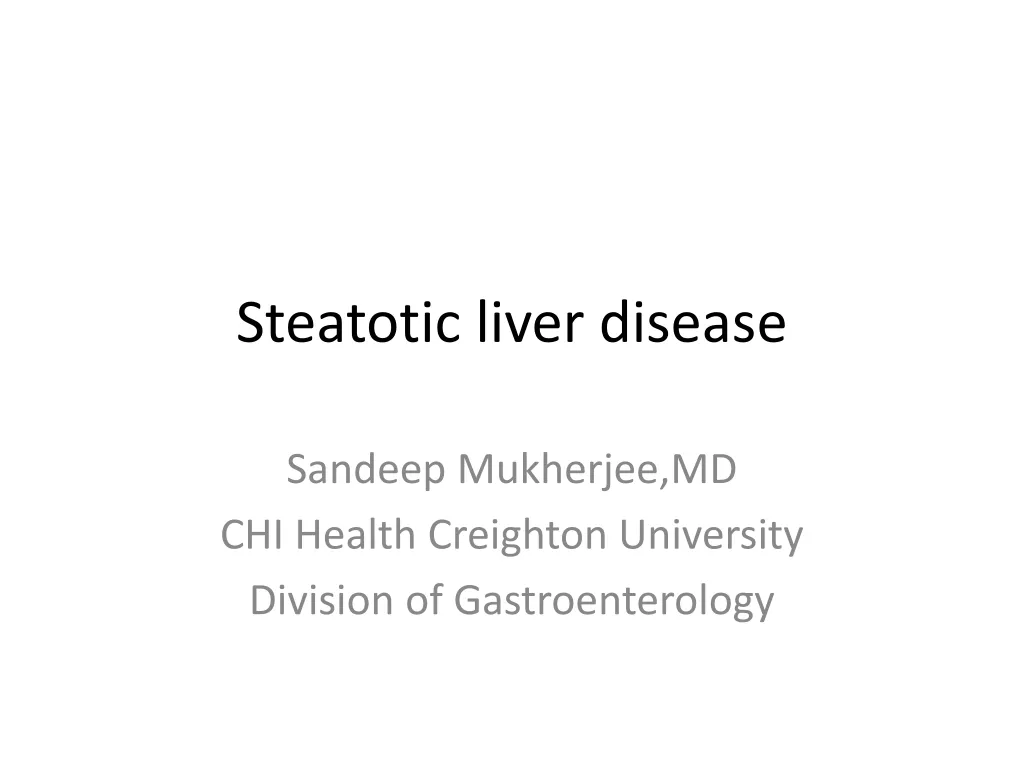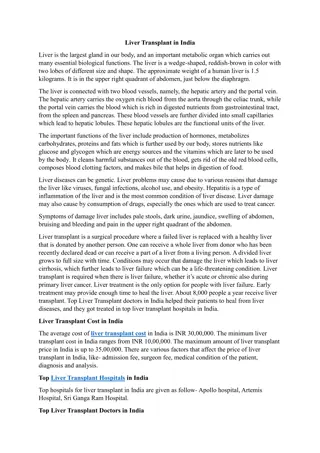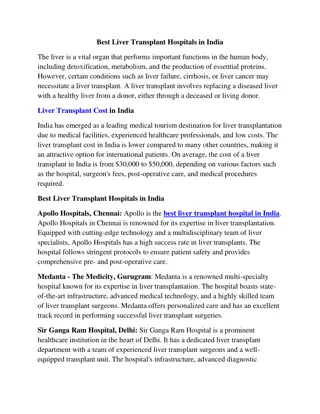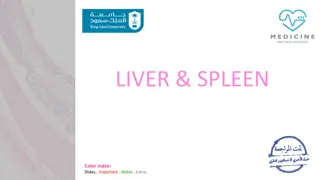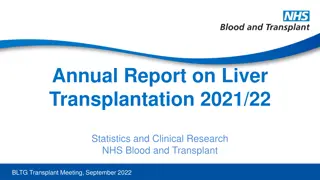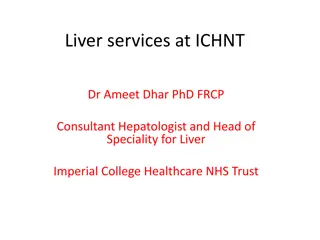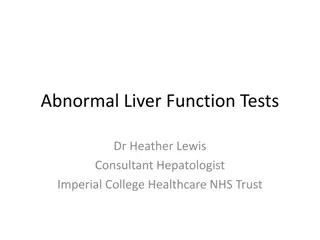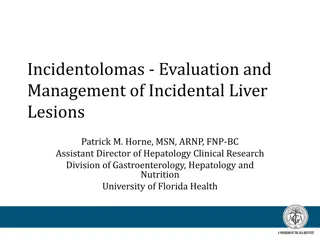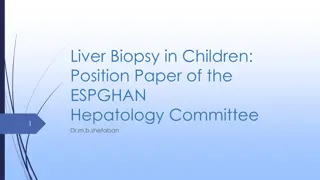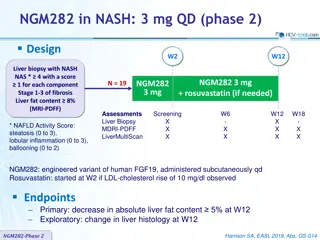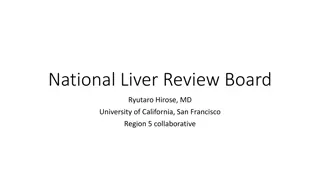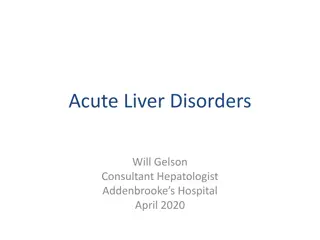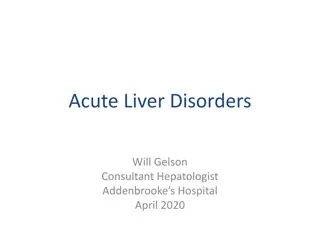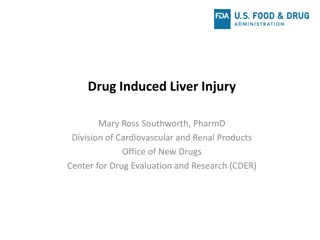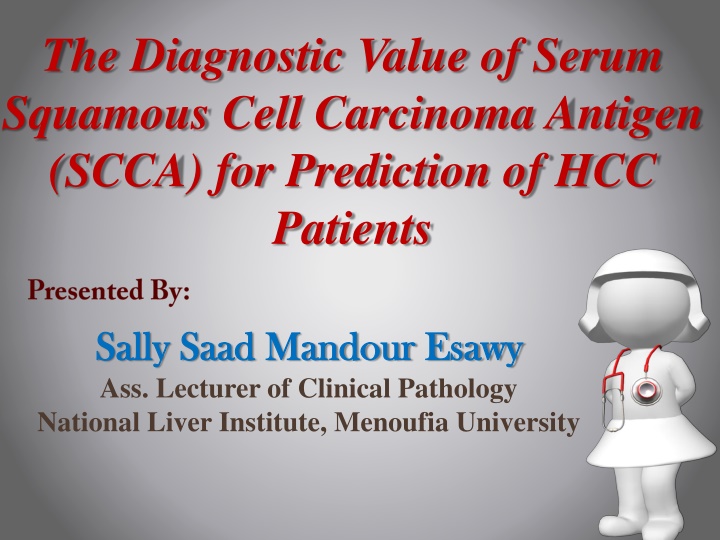
Diagnostic Value of Serum SCCA for HCC Prediction
This study investigates the diagnostic value of Serum Squamous Cell Carcinoma Antigen (SCCA) in predicting Hepatocellular Carcinoma (HCC) in patients. HCC is a prevalent form of primary liver cancer globally, with chronic infections such as hepatitis B and C being major risk factors. Early detection of HCC is crucial for favorable outcomes, as small tumors detected through surveillance have better treatment options and outcomes. While AFP is commonly used, SCCA may offer additional diagnostic value for HCC screening.
Download Presentation

Please find below an Image/Link to download the presentation.
The content on the website is provided AS IS for your information and personal use only. It may not be sold, licensed, or shared on other websites without obtaining consent from the author. If you encounter any issues during the download, it is possible that the publisher has removed the file from their server.
You are allowed to download the files provided on this website for personal or commercial use, subject to the condition that they are used lawfully. All files are the property of their respective owners.
The content on the website is provided AS IS for your information and personal use only. It may not be sold, licensed, or shared on other websites without obtaining consent from the author.
E N D
Presentation Transcript
The Diagnostic Value of Serum Squamous Cell Carcinoma Antigen (SCCA) for Prediction of HCC Patients Sally Saad Mandour Esawy Sally Saad Mandour Esawy Ass. Lecturer of Clinical Pathology National Liver Institute, Menoufia University
Introduction Introduction
Introduction Introduction Hepatocellular Carcinoma (HCC) is the most common type of primary liver cancer which shows a growing (Vauthey and Brouquet,2013) Each year, hepatocellular carcinoma is diagnosed in more than half a million people (El-Serag, 2011) incidence worldwide In Egypt, hepatocellular carcinoma (HCC) is the second most common cancer in men and the 6th most common cancers in women (GLOBOCAN 2008)
Introduction Introduction The development of hepatocellular cancer is cirrhosis of the liver. Chronic infections with the hepatitis B virus (HBV) and the hepatitis C virus (HCV) have been involved in about 80% of cases of HCC worldwide (Marrero and Lok, 2004) major clinical risk factor for the
Introduction Introduction HCC detected after the onset of symptoms has a dismal prognosis with only (0% 10%) 5 years survival. In contrast, small HCC detected by surveillance can be curable. As potentially curative treatment modalities are available. Identification of HCC at early stage with a good screening test is, therefore, imperative for favourable outcome (Sarwar et al, 2014).
Introduction Introduction Alpha-fetoprotein (AFP) is the major biomarker used for HCC diagnosis, however, its use in the early detection of HCC is limited (Hussein et al, 2008). Serum AFP as a marker for HCC has low sensitivity and high specificity (Sun et al, 2008)
Introduction Introduction Squamous cell carcinoma antigen (SCCA), a serine protease inhibitor, is physiologically expressed in the skin and other squamous epithelial cells. SCCA levels were significantly elevated in HCC patients, compared to patients with cirrhosis only or normal subjects (Giannelli et al, 2005).
Aim of the work Aim of the work
Aim of the work Aim of the work This study aimed to evaluate the significance of Squamous cell carcinoma antigen serum level in hepatocellular carcinoma and liver cirrhosis in relation to alpha-feto protein as a conventional marker for HCC, lacking disease sensitivity.
Subjects and methods Subjects and methods
Subjects and methods Subjects and methods This study was carried out at Clinical Pathology Departments, Faculty of Medicine and National Liver University from June 2012 to November 2013. Institute, Menoufia The study included 30 patients with HCC and 30 patients with liver cirrhosis. In addition to 17 unrelated healthy adult subjects, with matched age and gender, no previous history of liver diseases and negative for HBs Ag and HCV Ab, were included as controls.
Subjects and methods Subjects and methods The subjects were classified into 3 groups according to clinical findings, laboratory findings, serological tests and abdominal ultrasound as follows: Group I : This group included 30 patients with cirrhotic liver disease. Group II: This group included 30 patients with HCC. Group III: This group included 17 control subjects with matched age and gender.
Subjects and methods Subjects and methods Abdominal ultrasonography. CT scanning. Laboratory investigations including: - Complete blood count. - Kidney functions (serum urea & creatinine) - Liver Profile including total bilirubin (TB), direct bilirubin (DB), Alb, AST, ALT, and prothrombin concentration - Hepatitis viral markers ( HBsAg and HCV Ab) - Serum level of alpha fetoprotein and squamous cell carcinoma antigen by enzyme linked immunosorbent assay.
Results Results
Results Results Group I Group II Group III Test of significa nce (cirrhotic) (HCC) (controls) N=30 N=30 N=17 p-value AFP >50 g/L AFP <50 g/L Kruskal Wallis- test N=19 N=11 (Mean SD) (Mean SD) (Mean SD) AFP ( g/L) 25379 15.7 7.41 8.41 3.27 0.94 48.3 <0.001 34348 17.4
AFP ( ug/L) 16079.2 20000 15000 10000 5000 7.41 3.27 0 Group I Group II Group III Figure (1) the mean values of AFP level reported in studied groups
Results Results Group I Group II Group III Test of significance (cirrhotic) (HCC) (controls) N=30 N=30 N=17 p-value Kruskal Wallis-test (Mean SD) (Mean SD) (Mean SD) SCCA 1.20 1.65 2.0 4.73 1.01 0.35 1.41 0.49 ( g/L)
SCCA (ug/L) 2 2 1.8 1.2 1.6 1.01 1.4 1.2 1 0.8 0.6 0.4 0.2 0 Group I Group II Group III Figure (2) the mean values of SCCA level reported in studied groups
Results Results Group I Group II p-value r p-value r Age 0.11 0.58 0.14 0.45 Hb (gm/dl) -0.16 0.39 -0.29 0.12 Plt \cmm -0.19 0.29 -0.17 0.36 Pt conc % 0.01 0.95 0.03 0.86 ALT IU/L -0.19 0.32 0.08 0.66 AST IU/L -0.17 0.37 0.05 0.78
Results Results Group I Group II p-value r p-value r Total Bilirubin mg\dl Direct Bilirubin mg\dl Alb g/dl -0.15 0.44 -0.08 0.66 -0.13 0.51 -0.07 0.70 -0.31 0.09 -0.12 0.54 Urea mg/dl 0.39 0.03* 0.11 0.55 Creatinine mg/dl AFP g/L 0.42 0.02* 0.19 0.29 -0.15 0.44 -0.09 0.64
Results Results < 6 cm > 6 cm Test of significance N=13 N=17 p-value Mann Whitney U- test (Mean SD) (Mean SD) AFP ( g/L) 5279.6 15715.7 24337.7 35424.2 2.70 0.007 SCCA ( g/L) 1.08 1.04 2.71 6.20 0.14 0.89
Results Results Test of significance Yes N=9 No N=21 p-value Mann Whitney U-test (Mean SD) (Mean SD) AFP ( g/L) 30462.6 37577.6 9914.9 24249.7 2.42 0.02 SCCA ( g/L) 1.11 1.27 2.38 5.59 0.35 0.73
Results Results Cut-off Area under values Sensitivity Specificity PPV NPV the curve ng/ml AFP 0.87 258 60% 100% 100% 71% SCCA 0.56 0.5 73% 44% 57% 62%
Results Results Sensitivity Specificity NPV Accuracy PPV 100% 47% 65% 100% 0.73%
Results Results Source of the Curve _____ AFP g/L _____ SCCA g/L _____ Reference Line
Conclusion Conclusion
Conclusion Conclusion We conclude that despite the slightly high sensitivity of SCCA, AFP remains a relatively good diagnostic marker for HCC with higher specificity than SCCA which lacks accuracy as a diagnostic test for HCC in Egyptians. However combination of the two markers improves their sensitivity as screening tests for hepatocellular carcinoma.
Recommendati Recommendation ons s
Recommendations Recommendations More studies on a large scale and larger samples sizes are needed to assess the diagnostic as well as the prognostic value of SCCA in patients with HCC with different etiologies of liver disease not only post viral cirrhosis with inclusion of more hepatitis B patients in the study. Further studies focusing on the quantitative assessment of SCCA in tumor and peritumoral tissues should be correlated with serum studies to improve the discriminatory power of SCCA between HCC patients and controls. We also recommend inclusion of a new group of patients with different cancer etiologies other than HCC for better assessment of SCCA specificity as a tumor marker for hepatocellular carcinoma

